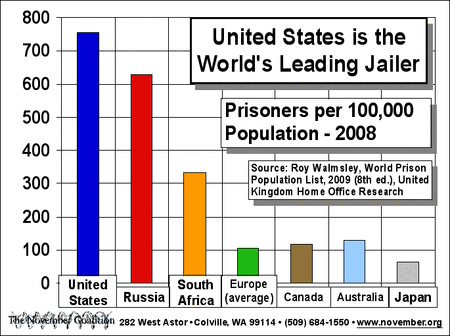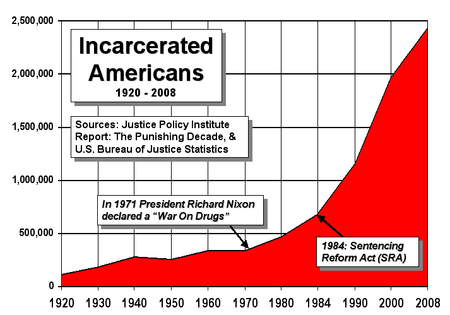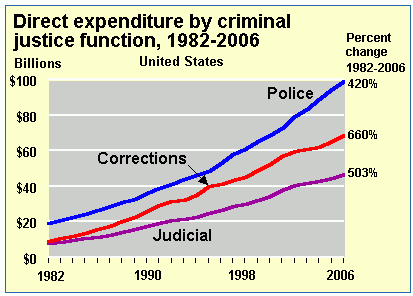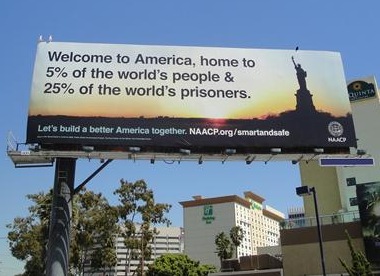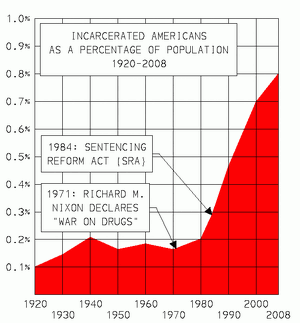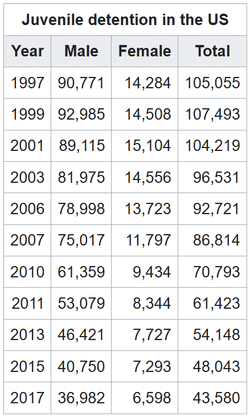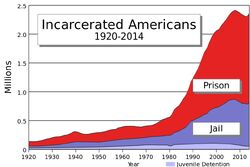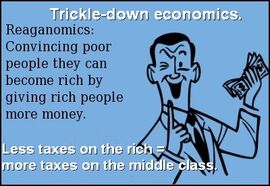Timeshifter (talk | contribs) |
Timeshifter (talk | contribs) No edit summary |
||
| Line 3: | Line 3: | ||
|{{Template:Incarceration rates worldwide}} |
|{{Template:Incarceration rates worldwide}} |
||
|} |
|} |
||
| − | :''Share |
+ | :''Share links: [http://www.cannabis.wikia.com/drugwar www.cannabis.wikia.com/drugwar] and [http://www.cannabis.wikia.com/majority www.cannabis.wikia.com/majority]'' |
:''See categories: [[:Category:Charts and graphs|Charts and graphs]] and [[:Category:Maps|maps]].'' |
:''See categories: [[:Category:Charts and graphs|Charts and graphs]] and [[:Category:Maps|maps]].'' |
||
:''See also: [[Private prisons and private power]].'' |
:''See also: [[Private prisons and private power]].'' |
||
Revision as of 13:50, 12 August 2012
Top
|
- Share links: www.cannabis.wikia.com/drugwar and www.cannabis.wikia.com/majority
- See categories: Charts and graphs and maps.
- See also: Private prisons and private power.
- See: Portal: The U.S. Drug War. Republicans lead. Democrats follow. Everybody pays.
The majority of all prisoners in the USA (federal, state, local jails) are incarcerated due to the drug war.
| The U.S. drug war inmate majority is shown by adding together drug offenses, crimes to get money for drugs, drug trade crimes, drug-related parole violations, etc.. |
True cost of drugs: More than half of inmates currently in U.S. federal prisons were convicted of narcotics offences. June 12, 2011. Daily Mail. The article discusses state prisons, too. Also, it discusses many aspects of drug-related crimes. For example; "The second main area is economic-related crimes where an individual commits a crime to fund a drug habit. These include theft and prostitution."
Dissenting Opinions of Judges, Federal Drug Sentencing, Mandatory Minimum Sentences. A list of many articles by judges. At November Coalition.
Jimmie Carter: Call Off the Global Drug War. In New York Times: "Former California Gov. Arnold Schwarzenegger pointed out that, in 1980, 10 percent of his state’s budget went to higher education and 3 percent to prisons; in 2010, almost 11 percent went to prisons and only 7.5 percent to higher education. Maybe the increased tax burden on wealthy citizens necessary to pay for the war on drugs will help to bring about a reform of America’s drug policies." -- June 16, 2011 article.
"Welcome to America, home to 5% of the world's people & 25% of the world's prisoners." NAACP, ACLU File Lawsuit Against City of Philadelphia for Rejecting Criminal Justice Reform Ad. Article by NAACP. Lawsuit filed October 19, 2011 during the period of the Occupy movement. Also see the ad banner article by Courthouse News Service. The drug war and prisons are big business, and a big part of how the 1% controls the 99%. See Facebook comments about the banner. The Republican Party leads the racist drug war.
Incarceration peaked in the USA in 2008. <<--See that article for sources, stats, and charts for the banner. Most inmates are incarcerated due to the drug war.

Image info. See billboard and stats.
Length of sentences causes the huge U.S. incarceration rate
|
American Exception. Inmate Count in US Dwarfs Other Nations'. April 22, 2008. New York Times. Page 1, Section A, Front Page. Archive. From the article (emphasis added):
- Still, it is the length of sentences that truly distinguishes American prison policy. Indeed, the mere number of sentences imposed here would not place the United States at the top of the incarceration lists. If lists were compiled based on annual admissions to prison per capita, several European countries would outpace the United States. But American prison stays are much longer, so the total incarceration rate is higher. ... "Rises and falls in Canada's crime rate have closely paralleled America's for 40 years," Mr. Tonry wrote last year. "But its imprisonment rate has remained stable."
Incarceration Nation: "On June 30, 2006, an estimated 4.8% of black men were in prison or jail, compared to 1.9% of Hispanic men and 0.7% of white men. More than 11% of black males age 25 to 34 were incarcerated. Black women were incarcerated in prison or jail at nearly 4 times the rate of white women and more than twice the rate of Hispanic women." - Source:
- Prison and Jail Inmates at Midyear 2006 (page 1 of the PDF file). United States Bureau of Justice Statistics.
Law Enforcement Against Prohibition (LEAP). LEAP - Matthew Fogg (former Chief Deputy US Federal Marshal): "Drug prohibition helps the US maintain a racial apartheid prison industrial complex."
The New Jim Crow: How the War on Drugs Gave Birth to a Permanent American Undercaste. NORML Blog. By: Russ Belville, NORML Outreach Coordinator.
Michelle Alexander's book, The New Jim Crow: Mass Incarceration in the Age of Colorblindness.
2003. Federal Judge Quits, Calls Judicial System Unjust. Associated Press (AP) story, National Public Radio interview, and Judge John S. Martin's statement. "The result, he said, is a slew of lengthy prison sentences for low-level drug dealers 'who society failed at every step.' ... While many judges have criticized sentencing guidelines, it is unusual for a judge to publicly cite the frustrations of the job in stepping down." -June 25 2003 AP story. See also: Let Judges Do Their Jobs. By Hon. John S. Martin Jr..
| Timeline chart. The majority of U.S. inmates are in due to the drug war. The number of inmates in the USA has increased almost 5 times over since 1980. [12] |
Mandatory Minimum sentences or "truth in sentencing"
| Some people don't know that the National Rifle Association had a large part in causing the huge increase in the U.S. incarceration rate. The NRA strongly lobbied state-by-state for mandatory minimum sentences (also known as "Truth in Sentencing"), and "Two and Three Strikes" laws. Mandatory-minimum sentences, and long sentences in general (compared to other nations), are the root cause of the astronomical US incarceration rate according to a New York Times article. The majority of people incarcerated in the U.S. are in prison or jail due to drug-related offenses, crimes to get money for drugs, or drug-related parole or probation violations. |
|
See Wikipedia: Mandatory sentencing. See also this page. Mandatory Minimum sentencing is oftentimes used for non-violent crimes such as drug possession. It is a modern-day way to create concentration camps for drug-using "undesirables." Sentences that usually do not allow parole until at least around 80% of the sentence served. Federal laws, and most states, have mandatory minimums. The majority of U.S. prisoners are in due to the drug war in some way or another.
See Wikipedia: War on Drugs, and Wikipedia: Sentencing Reform Act.
 USA: Peak of 7.3 million people in 2007 under adult correctional supervision: On probation or parole, or incarcerated in jail or prison. About 3.2% of the U.S. adult population, or 1 in every 31 adults. More info here. See template. |
| Chart below is from a July 2000 report: |
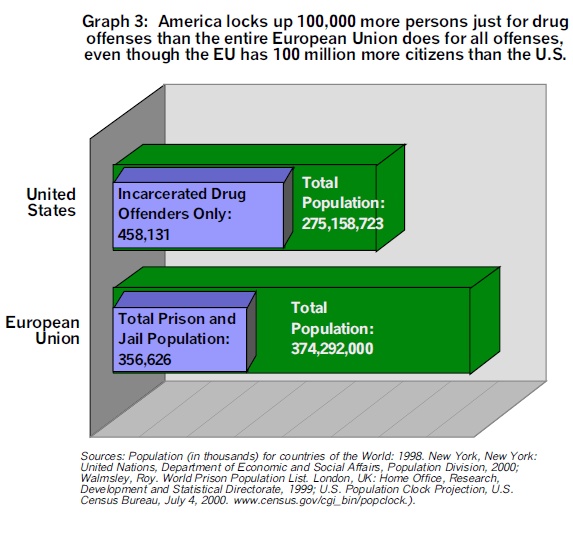 From this July 2000 report: Poor Prescription: The Costs of Imprisoning Drug Offenders in the United States. |
Majority of inmates are in due to U.S. drug war

|
| Tricky Dick Nixon (above) has won his drug war! Corporatist Dictatorship! The Halliburton Prison-Industrial Complex. A Nixonian "enemies list" that almost everyone is on at some time. |
Republican evil, Democrat complicity, corporatist control: The Drug-War Industrial Complex.
- Drug War Invented by Nixon to Extend His Power. By Fintan O'Toole. Aug. 13, 1999. Irish Times.
In June 1971 Richard Nixon declared a "War on Drugs."
"Nearly one in four persons (23.7%) imprisoned in the United States is currently imprisoned for a drug offense. The number of persons behind bars for drug offenses (458,131) is roughly the same as the entire prison and jail population in 1980 (474,368)." -- From this July 2000 report: Poor Prescription: The Costs of Imprisoning Drug Offenders in the United States. See also: [3].
Number and percentage of prisoners whose primary and/or most serious crime was a drug offense: 8% in 1980. 23% in 1998. Based on federal estimates of state and federal drug prisoners. Source: Bureau of Justice Statistics. Chart from 1980 on.
Crimes concerning money for drugs
"The FBI has reported that almost one-third of people convicted of robbery and burglary, and more than one-quarter of people convicted of larceny, committed their crimes to get money for drugs. Moreover, 6.5 percent of the murders in the United States in 1990 occurred in narcotics-related circumstances" -- Rethinking America's wasteful war on illicit drugs. By Jerry V. Wilson (former chief of police for the District of Columbia). Jan. 18, 1994. Washington Post.
The Nov. 2, 1995 Chicago Tribune reported: "The latest Bureau of Justice Statistics [BJS] survey of U.S. prison inmates in 1991 found that 27 percent of robbers admitted they committed crimes to buy drugs; 30 percent of burglars said so, and 5 percent of convicted murderers did." -- See Table 3 in the BJS report Fact Sheet: Drug-Related Crime. September 1994, NCJ–149286.
"According to the 1991 joint survey of Federal and State prison inmates, an estimated 17 percent of State prisoners and 10 percent of Federal prisoners reported committing their offense to get money to buy drugs; of those incarcerated for robbery, 27 percent of State prisoners and 27 percent of Federal prisoners admitted committing their offense to get money to buy drugs (see table 3). In 1997, 19 percent of State prisoners and 16 percent of Federal inmates said that they committed their current offense to obtain money for drugs. These numbers represent a slight increase from the 1991 figures."
http://www.whitehousedrugpolicy.gov/publications/factsht/crime/index.html#table3
"In 1988, just over half of the murders in the city [New York City] were 'drug-related.' But once the researchers examined the circumstances of the murders, they discovered that the clear majority, 74 percent, were results of the drug trade, not drug use (14 percent) or the need to get money for drugs (4 percent)." -- July 15, 1999. Washington Post. Op-ed from the Drug Policy Foundation. Emphasis added.
http://www.mapinc.org/drugnews/v99.n731.a13.html
"The percentage of homicides thought to be drug-related reflects both the frequency of such crimes as well as how the relationship is specified. 'What proportion of homicides is drug-related?' This simple question is difficult to answer. The FBI's definition is specific but limited. Cities or police departments may have broader but inconsistent definitions. For offenses not as reliably reported or as thoroughly investigated as homicides, the question is even more difficult because complete information is not systematically available at the national level for any definition of 'drug-related.' "
See the chart below.
http://www.whitehousedrugpolicy.gov/publications/factsht/crime/index.html#whystatistics
| Drug-related homicide rates as defined using differing criteria in four cities, 1990 | ||||
|---|---|---|---|---|
| Percentage drug-related | ||||
| City 1 | City 2 | City 3 | City 4 | |
| Definitional criteria | 36.0% | 25.7% | 39.0% | 44.6% |
| Committed during commission of a narcotics felony | x | x | x | |
| Dispute between dealers | x | x | ||
| Offender under the influence of drugs | x | |||
| Victim under the influence of drugs | x | x | ||
| Source: Data were obtained by the ONDCP Drug Policy Information Clearinghouse. | ||||
Parole violations and drugs
'*Parole violations and drugs. 16.1% is the percentage of parole violators returned to state prisons in 1997 for drug related violations; for failing drug tests, possession of drugs, failing to report for drug testing, failing to report for alcohol or drug treatment. Info is from Table 21 of this report:
- Trends in State Parole, 1990-2000. NCJ 184735. October 2001. U.S. Bureau of Justice Statistics. See Table 21.

See chart source with links.
See also
World incarceration rates
- Share link: compare. This article was written by Timeshifter. See many drug war charts and maps. And: Drug war causes high U.S. incarceration rate. And: The U.S. Drug War. Republicans lead. And: Drug War, mandatory minimum sentencing, handguns. And: The number of people incarcerated in the USA peaked in 2008.
Charts and maps
| See list of incarceration rates by country (b c). Compare the rates. Due to the Drug War and long mandatory sentences the USA had the highest incarceration rate in the world for awhile. See cost of U.S. drug war: 1.5 trillion dollars! |
| The majority of people incarcerated in prisons and jails in the USA are in due to drug-related offenses, crimes to get money for drugs, or drug-related parole or probation violations. Wikipedia: Drug-related crime. The number of inmates in the USA has increased almost 5 times over since 1980. It peaked in 2008. Obama's Democrat landslide in 2008 turned the incarceration rate around. The cost of the U.S. drug war is at least 1.5 trillion dollars. Cannabis is safer! Share link. |
|
-

USA: Peak of 7.3 million people in 2007 under adult correctional supervision: On probation or parole, or incarcerated in jail or prison. About 3.2% of the U.S. adult population, or 1 in every 31 adults. More info here. See template.
-

Timeline of U.S. incarceration in prisons and jails as a percentage of Americans of all ages. Peaked in 2008. See template. Image source and data.
USA. Adult and juvenile inmate stats. Share link.
-

Source: Correctional Populations in the United States, 2013. See Appendix Table 2 in PDF. From U.S. Bureau of Justice Statistics. Incarceration rate is per 100,000. See template. See juvenile detention numbers.
-

Obama helping turn around Reagan-Bush War on Pot, mandatory minimums, mass incarceration:
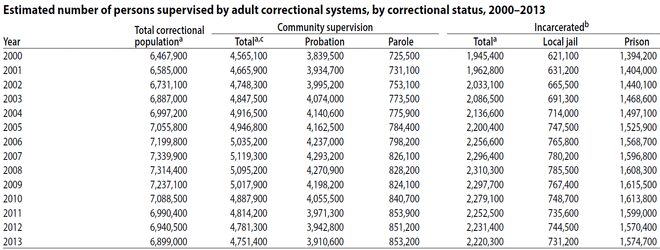
Source: Correctional Populations in the United States, 2013. See Appendix Table 5 in PDF.
-

Obama helped turn around the Reagan-Bush War on Pot, mandatory minimums, mass incarceration. See: US incarceration peaked in 2008.
-

Incarceration rates for adult males in U.S. jails and prisons by race and ethnicity. At midyear 2009, an estimated 4.7% of black non-Hispanic men were in prison or jail, compared to 1.8% of Hispanic men of any race, and 0.7% of white non-Hispanic men. Sources. More info: Race, ethnicity, and the drug war. See template.
Cannabis is safer
Return to top. Full site / Mobile. To Top or End. Note: This section and the following ones are at: Beyond drug war, debt, and wealth concentration. To single-payer healthcare and progressive taxation.
See articles: Cannabis is safer. And:
History of US Republican-led war on cannabis, and their lies about its health effects.
See 2024 GMM-420 on Fandom and on Shoutwiki. See 2024 talk page (no need to log in) to leave event links, and especially compilations.
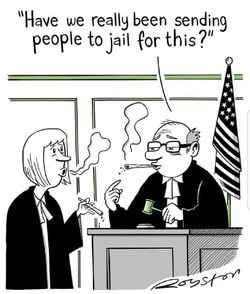
| To Top. Or End. Or Articles. |
Portugal's decrim
Return to top. See: Portugal. Cannabis-related links and decriminalization. See the utter failure of the US Republican-led drug war and mass incarceration: It is killing Americans at the rate of one Vietnam War every 6 months.
There were around 112,100 US drug overdose deaths in the 12-month period ending August 31, 2023, at a rate of 307 deaths per day. 335 deaths per million US population. Only around 10 to 72 total deaths per year in Portugal, a country with universal healthcare, and where all drugs have been decriminalized since 2001. See timeline table of yearly overdose deaths by European country.
 |
| Chart from: December 15, 2020 article: Scotland's drug death crisis in six charts. BBC News. |
Harm reduction
Return to top. End the expensive, incarceration-heavy US drug war with Portuguese and Canadian single-payer universal healthcare, and Portuguese decriminalization.
Government debt
Return to top. Share link: Debt ceiling. See: Wikipedia: US debt ceiling.
Save $1.5 trillion:
Per year in the US:
Single-payer
Return to top. Republicans oppose single-payer universal healthcare. US would save 1.5 trillion dollars per year if it instituted Canadian universal healthcare. That is 5.4% of US GDP.
Canada spent 11.2 percent of its GDP for total healthcare costs in 2022. US spent 16.6 percent in 2022. Former US Lawmaker Finally Enjoys Social Policies He Fought for—In Europe.
Medical bankruptcies
Return to top. See: Health Care Costs Number One Cause of Bankruptcy for American Families. And: Americans have high personal medical debt, unlike Canadians. [4][5][6]. High student debt is another problem Americans have due to Republican politicians. Unlike Canadians. Changing the age of adulthood to 17 would free up a year of education money.

US household debt at all time high. By quarters. 1st quarter 2003 to recent times. Chart.
US is Broke, not Woke. Healthcare spending and debt ceiling.
| To Top. Or End. Or Articles. |
Richer Canadians
Return to top. Many sleepy Americans can't do the math concerning healthcare costs and medical debt. Also, incarceration and family debt due to the GOP-led war on drugs. Also US student debt, and US household debt due to GOP's low minimum wages, etc...

Canadians are richer on average than Americans, and they have more energy because Canadians don't have to take 3 jobs, go bankrupt, or sell their homes, due to medical and student debt. See Wikipedia: List of countries by total health expenditure per capita. See: Student debt balance is forgiven after 15 years payment in Canada.
| USA. Two Leading Economists Say Medicare for All Would Give 'Biggest Take-Home Pay Raise in a Generation'. |
| Medicare spends 1.4% on bureaucracy. Insurance companies spend 16-20%. See chart. We need Medicare for All. |
Healthier Canadians
Return to top. See: End drug war with universal healthcare and decriminalization. Cannabis is legal across Canada. See Wikipedia: Cannabis in Canada.
|
US Republicans Voted Often to Kill Coverage of Pre-Existing Conditions. [7][8][9].
Health spending
Return to top. Republicans are responsible for the large US government deficit. Because they support the wasteful US healthcare system over the much cheaper single-payer universal healthcare in Canada and elsewhere. See: Canadian single-payer universal healthcare versus US healthcare.

See more countries.
| Wikipedia: Health spending by country. Percent of GDP. See Gross domestic product. 11.2% for Canada in 2022. 16.6% for the US in 2022. |
| See Wikimedia chart source. |
| Wikipedia: Health spending per capita. OECD countries. US dollars, using economy-wide PPPs. Public, private, and total expenditures. $6,319 for Canada in 2022. $12,555 for the US in 2022. |
| See Wikimedia chart source. |
Poor and sick:
Return to top. Canadians are healthier on average, and their preventive healthcare is much cheaper! Versus US Emergency Room care. See Wikipedia: Health spending as a percent of GDP by country (gross domestic product). And: Wikipedia: List of countries with universal health care.
| "The Easy-to-Digest Republican Party Platform" from Michael Moore has this image: "Keep 'em poor and sick". |
| To Top. Or End. Or Articles. |
Republican states;
Prohibition plus;
Return to top. See Wikipedia: Republican states.
See article: US Republican states. It's not just cannabis prohibition. Many maps. It's also their low minimum wages, high Covid death rates, poor healthcare, high household debt, high gun death rates, high homicide rates, high incarceration rates, etc.. See: Drug war and other excessive uses of force. They are autocratic gerrymandered states that have long avoided federal oversight due to the Republican filibuster. See Wikipedia: Filibuster in the United States Senate.
The US Republican Party wants to concentrate wealth at the top. So they want most people to be Broke, not Woke: Trickle-down economics. See: Beyond drug war and conservatism.
The federal minimum wage would be $13.46 in 2022 dollars if its real value had remained at the 1968 level. Even more in 2023 dollars. See graph below.
| Note the low minimum wages in the Republican south: |
| See Wikimedia SVG map. See PNG map [10] (for Facebook, etc.). |
| History of the US federal minimum wage. $13.46 inflation-adjusted peak in 1968. $7.25 an hour now due to Republican filibusters in the US Senate. See Wikimedia GIF chart. |
- See Wikipedia: Republican states.
- Wikipedia: List of US states by minimum wage.
- Wikipedia: List of European countries by minimum wage.
Voter suppression;
Return to top. Vote out the many Republicans supporting backward cannabis laws. It is purposely made more difficult by the lack of no-excuse postal voting. Just one example of Republican voter suppression in GOP states. Such as many states in the south.
See Wikipedia: Postal voting in the United States.
Lies of GOP radio
Return to top. Google image search: Top right wing radio hosts.
How Fox News and the Right-Wing Media Machine Made My Dad Crazy. Republicans dominate talk radio. Especially in the Republican south with its backward cannabis laws.
See Wikipedia: Conservative talk radio. A percentage of people in many states do not have access to broadband internet, and desktop or laptop computers. Cell phones are a poor substitute for many people. So they are left with Republican misinformation radio.
| To Top. Or End. Or Articles. |
Senate filibuster
Return to top. A minority of Senators should not be able to block cannabis laws supported by the majority of Americans.
The War on Cannabis. It accelerated in the US, and that's where it will end. US Congress could legalize, reschedule, or remove cannabis from the federal schedule if the Republican filibuster were gone. Vote in US Senators who will abolish it. [11][12][13][14]. Senators Manchin or Sinema could abolish it now.
Electoral college
Return to top. Presidents should not be elected who do not receive the highest number of votes.
Abolish the electoral college. Imagine the US without the 12 years of the Bush and Trump presidencies and their backward cannabis policies.
Ranked voting
Presidential veto
Return to top. Presidents should not be able to block cannabis laws supported by the majority of Americans.
See Wikipedia: Veto power in the United States.
| To Top. Or End. Or Articles. |
End war powers
Return to top. Nixon, Reagan, and Bush are responsible for the US War on Drugs, and the lie that massive incarceration is a solution. See more lies in
Reagan's frequent demonization of cannabis.
Presidents have too much power. Wars later determined to be started based on lies of Presidents, or done in secret:
Vietnam War: President Johnson and the lie of the Gulf of Tonkin incident.
Cambodia: Nixon and Kissinger's secret B-52 carpet bombing campaign that helped create the unrest that led to Pol Pot's genocidal regime. And Kent State shootings in US.
Iraq War: President Bush and the lie of the weapons of mass destruction in Iraq.
Trump and Biden
Return to top. Institute a mandatory retirement age for US Congress members and the President. [15]. Mandatory retirement exists for many US judges. Both Donald Trump and Joe Biden are too old to be President. And Trump is just too dumb: Video: Robert De Niro on Trump Being “So F**king Stupid”. See Robert Reich: Seriously, again, how dumb is Trump? And: Trump’s Brain Is Not Okay. An expert’s view of Trump’s mental slide into dementia.
Generic Democrats
Return to top. Biden and Trump both underperform generic opponents, poll finds. A Plea to Biden: If You Truly Want to Prevent Trump Authoritarianism, Please Withdraw. Trump was not good for cannabis reform the last time around. We need more cannabis reform. That does not come from the Republican Party. Generic ballot : 2024 Polls | FiveThirtyEight. Biden needs to drop out. March 09, 2024 Newsweek report on poll: Joe Biden Voters Tell Him to Drop Out.

Source. Text added later. More "flying hair" photos.
Gaza. Canada vs US
Return to top. Compare genocidal American politicians to Canada's politicians stopping military aid to genocidal Israel. Read EXCERPT: Bernie Sanders: "This bill also provides another $3.3 billion in U.S. military aid for Netanyahu’s right-wing government to continue this barbaric war. The Netanyahu government should not receive another penny from U.S. taxpayers."
Gallup Poll chart below showing US change from majority approval (Nov. 2023) to majority disapproval (March 2024) of Israeli military action in Gaza. Source: Majority in U.S. Now Disapprove of Israeli Action in Gaza. March 27, 2024 by Jeffrey M Jones. Gallup Poll.
Tax cuts for rich
April 15, 2024. Biden: "If Congress enacted President Biden’s tax plan, tens of millions of workers and families would have their taxes cut, nobody making less than $400,000 would pay a penny more in taxes, and the wealthy and big corporations would finally pay their fair share—which would fully pay for the President’s tax cuts and investment agenda."
Democrats who attack the rich do better in elections. The party should take notice. Republican dynasties created by regressive taxation: See: The poster child for the perils of dynastic wealth. By Robert Reich.
| Trump's 2017 tax cuts for the rich. |
| On average, taxpayers in the income groups highlighted in yellow will incur a net cost (shown as a positive figure as this reduces the budget deficit), due in part to reduced healthcare subsidies. Higher income taxpayers receive a benefit via tax cuts (shown as a negative number as this increases the budget deficit). The percent of taxpayers in each income group is also shown for the 2023 period. "Taxpayer" in the chart refers to a tax return, meaning it could represent one person or a married couple filing jointly, among other options. [16][17]. Commons source. |
Wealth inequality
Return to top. See: Wikipedia: Progressive tax. Mar 19, 2024: Sanders, UAW president press harder for shorter workweek. "Today, American workers are more than 400 percent more productive than they were in the 1940s. And yet, despite this fact, millions of our people are working longer hours for lower wages," they wrote. "In fact, 28.5 million Americans now work over 60 hours a week and more than half of full-time employees work more than 40 hours a week." After adjusting for inflation, American workers make almost $50 less a week than they did 50 years ago, they said.
Jan 24, 2024 article: $8.5 Trillion in Untaxed Assets: Data Shows Why 'We Need a Billionaire Income Tax'. EXCERPTS: analysis found that the wealth of America's billionaires and centimillionaires has exploded in recent years as Republicans have enacted massive tax cuts for the rich ... "The cumulative $8.5 trillion of unrealized capital gains held by America's billionaires and centi-millionaires in 2022 has jumped by more than half–or $3.2 trillion–just since the last Fed survey year of 2019," END.
USA. The sorry state of the nation.
| US federal income tax rate on billionaires averages only 8.2%. Click image to enlarge. |
| "Most taxpayers, including firefighters and teachers, average a federal income tax rate of approximately 13.3%." |
Minimum wage
Return to top. Beyond drug war, debt, and wealth concentration. To single-payer healthcare and progressive taxation. Simultaneous with the Republican-led drug war the GOP used the Senate filibuster to undemocratically severely restrict increases in the minimum wage at the federal level, and in GOP states.
| US minimum wage would be $23 an hour in 2021 if it had kept up with productivity. |
| Source article. [18]. |
- A $15 minimum wage would cost jobs, right? Probably not, economists say.
- There’s More Evidence That Raising the Minimum Wage Won’t Cost Jobs.
- The U.S. has one of the stingiest minimum wage policies of any wealthy nation. Washington Post.
| To Top. Or End. Or Articles. |
Global warming
Return to top. World Population Clock: 8 Billion People (LIVE). We need more trees and less people. More oxygen, less carbon dioxide. To slow down global warming. "Assuming no net migration and unchanged mortality, a total fertility rate of 2.1 children per woman ensures a broadly stable population." - Fertility rates. OECD Data. See country graphs. Also, inflation comes from an increasing population sharing one planet's resources.
Many US Republican leaders oppose birth control and abortion rights (even early abortion). Another reason besides their backward cannabis laws to vote them out. Birth control and abortion (especially early abortion) is legal (even free) in many countries. That needs to expand further.
We need the lowest curve below, by lowering the birth rate.

See page 30 of source.
Immigration
Return to top. The US and Europe can't import all the overpopulation of the world. Europe, especially, is already too densely populated. US Democrats and progressives in Europe need to limit immigration, or they will lose power, and cannabis policies will stagnate under right wing rule. Taxes on the rich will be cut yet more, which by definition means middle class taxes will go up, or stay up, to pay for it. Wikipedia: List of countries and dependencies by population density.

See source.
| To Top. Or End. Or Articles. |
Roswell. Warming
Share link: Roswell UFO. Much UFO technology has been back engineered, and its carbon-free energy could end global warming. See Stephen Greer playlist. [19][20][21][22][23] [24][25][26][27] [28][29]. Wildest: [30][31]. See also the David Grusch disclosures at July 26, 2023 House hearing about US possession of aliens, alien bodies, alien craft, and back engineering: [32][33][34][35] [36][37][38][39][40] [41][42][43][44]. See History channel: [45][46][47][48]. National Geographic: [49][50].
See the July 8, 1947 Roswell Daily Record below. Image info. Click image to enlarge. Full-size is readable. See full text of saucer article. [51]. U.S. Army officer Walter Haut issued the initial "flying disc" press release. His 2002 notarized affidavit said there were 2 crash sites, and that he had seen a craft, alien bodies, and handled wreckage material. (see page 14 of pdf). It was released in a 2007 book after his death in 2005.

Walter Haut in 1947
Affidavit is on pages 239-242 of the 2022 edition: Witness to Roswell, 75th Anniversary Edition: Unmasking the Government's Biggest Cover-up (more eyewitnesses). 36 pages previewed in Google Books. Click "preview" button and scroll down to pages 239-240. Search within the book. There is an inexpensive Kindle ebook. Moonwalker Dr. Edgar Mitchell wrote the foreword. The 20 paragraph affidavit is online here: [52] (page 14). [53][54].
Haut's daughter, Julie Shuster, in 2002, 3 years before his death, "verbally discussed each and every sentence" of the affidavit with him. She said it was not a deathbed confession. See Sept 2007 MUFON UFO Journal. Issue 473. Page 15. And this article from Special Broadcasting Service. Archived. See Julie Shuster on IMDb.
Google search: Walter Haut 2002 Roswell affidavit. Articles about Haut:
30 June 2007: Roswell officer's amazing deathbed admission raises possibility that aliens DID visit. By Nick Pope. Same article also published here and here. Archived here and here.
5 June 2022: Roswell officer's deathbed confession about theory of alien cover up. By Declan Carey. Archived here.
14 May 2021: Ex-Army officer ADMITS he saw ‘alien the size of a 10-year-old child’ after famous Roswell UFO crash in incredible video. By Emma Parry. Archived here. This article has a short excerpt of the video.
May 2021: Roswell Officer Speaks From the Grave: Video Released, Confesses that Alien was "the size of a 10 year old". By Anthony Bragalia. Archived here. From article (emphasis added): "This video clip is part of a memoir video / oral history over two hours in length that covers many personal and professional aspects of Haut's life. The video was taken at the Roswell Museum in 2000 with friends Dennis Balthaser and Wendy Connors."
Galactic Pot March
![]() Return to top. See 2024 GMM-420 on Fandom and on Shoutwiki. Note: See the sections at the bottom of many pages: Beyond drug war, debt, and wealth concentration. To single-payer healthcare and progressive taxation.
Return to top. See 2024 GMM-420 on Fandom and on Shoutwiki. Note: See the sections at the bottom of many pages: Beyond drug war, debt, and wealth concentration. To single-payer healthcare and progressive taxation.
2024 talk page (no need to log in) for event links, and especially compilations.
| To Top. Or Articles. Categories. |
Full site / Mobile. Weed War. 2023. 2024. Years. Home. Republican states. Canada. Portugal. End.
Categories
